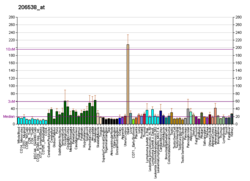Function
The MRAS gene is expressed specifically in brain, heart, myoblasts, myotubes, fibroblasts, skeletal muscles, and uterus, suggesting a specific role of M-Ras in these tissue and cells. [16] [17] M-Ras is involved in many biological processes by activating a wide variety of proteins. For instance, it is activated by Ras guanine nucleotide exchange factors and can bind/activate some Ras protein effectors. [18] M-Ras also weakly stimulates the mitogen-activated protein kinase (MAPK) activity and ERK2 activity, but modestly stimulates trans-activation from different nuclear response elements which bind transcription factors, such as SRF, ETS/TCF, Jun/Fos, and NF- kB/Rel. [17] [19] M-Ras has been found to induce Akt kinase activity in the PI3-K pathway, and it may play a role in cell survival of neural-derived cells. [20] Moreover, M-Ras plays a crucial role in the downregulation of OCT4 and NANOG protein levels upon differentiation and has been demonstrated to modulate cell fate at early steps of development during neurogenesis. [21] M-Ras, induced and activated by BMP-2 signaling, also participates in the osteoblastic determination, differentiation, and transdifferentiation under p38 MAPK and JNK regulation. [22] M-Ras is involved in TNF-alpha-stimulated and Rap1-mediated LFA-1 activation in splenocytes. [23] More generally, cells transfected with M-Ras exhibit dendritic appearances with microspikes, suggesting that M-Ras may participate in reorganization of the actin cytoskeleton. [16] In addition, it is reported that M-Ras forms a complex with SCRIB and SHOC2, a polarity protein with tumor suppressor properties, and may play a key role in tumorigenic growth. [24]
Clinical significance
In humans, other members of the Ras subfamilies carry mutations in human cancers. [25] Furthermore, the Ras proteins are not only involved in tumorigenesis but also in many developmental disorders. [25] For instance, the Ras-related proteins appear to be overexpressed in human carcinomas of the oral cavity, esophagus, stomach, skin, and breast, as well as in lymphomas. [26] [27] [28] [29] More currently, Ras family members such as R-RAS, R-RAS2 and also R-RAS3 have also been implicated as main factors in triggering neural transformation, with R-RAS2 as the most significant element. [30]
Clinical marker
A multi-locus genetic risk score study based on a combination of 27 loci, including the MRAS gene, identified individuals at increased risk for both incidence and recurrent coronary artery disease events, as well as an enhanced clinical benefit from statin therapy. The study was based on a community cohort study (the Malmo Diet and Cancer study) and four additional randomized controlled trials of primary prevention cohorts (JUPITER and ASCOT) and secondary prevention cohorts (CARE and PROVE IT-TIMI 22). [31]
This page is based on this
Wikipedia article Text is available under the
CC BY-SA 4.0 license; additional terms may apply.
Images, videos and audio are available under their respective licenses.







